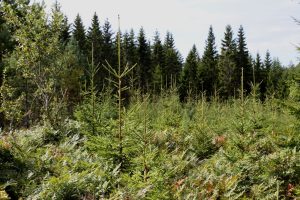Planting trees has become common among companies within different businesses that do not necessarily have anything to do with forestry. Recently we wrote about how Stihl supports tree-planting projects in Uganda and Borneo. Stihl is in the forestry business. So, why not? But why do companies like Nestlé and Renault plant trees?
Good tree planting
“Buy one of our products and we will plant a tree for you” is a typical marketing approach to make yourself look good. But is that the only reason companies like Renault, Nestlé, Barclays, and others decide to plant trees?
In a newsletter on the 10th of January, IUFRO (International Union of Forest Research Organizations) refers to a study on the subject. The authors of the study, Stephanie Mansourian and Daniel Vallauri selected all corporations present on the Fortune 500 list in France, Switzerland, and the United Kingdom. The chosen corporations were asked if they are engaged in tree planning at all. If yes; Why do, they do it? Where do they do it? With whom do they, do it? How pervasive is the phenomenon?
Great involvement in tree planting
In the study, to some extent, all 26 French companies, all 13 Swiss companies, and 21 of the 22 UK companies were involved in tree-planting projects. Either through subsidiaries or directly by the main company. In fact, 60 of the 61 largest corporations, active in all kinds of businesses, in the three countries were, in one way or another, planting trees. Impressive, but why do they do it?
It turned out, it depends on whom you ask. E.g., marketing departments saw the subject from another angle than the sustainability departments. However, the study managed to sort out eight main reasons why those companies plant trees.
Eight main reasons
- Carbon offsetting – generally the main reason
- Sustainable sourcing – the main reason for companies in the food business
- Communication – linked to marketing
- Team Building – e.g., tree-planting days for staff and customers
- Marketing – “buy this and we will plant a tree”
- Remediation – the primary reason for extractive industries
- Sustainable Development Goals – common in companies’ sustainability reports
- Ecosystem Services – securing ecosystem services that companies depend on
Where and how much?
According to the study, none of the Swiss companies planted “at home” (in Switzerland), while about half of the French and British companies planted trees within their respective country. Tree planting for carbon offset was mainly done in tropical countries.
In total, the 61 companies from the three countries in the study have contributed to the planting of approx. half a billion trees since 2000. If 1000 trees per hectare are assumed, that covers at least 530.000 hectares in 22 years. As a comparison, in Sweden 452 million trees were planted in 2021 (in one year), to replace felled forests on approx. 260.000 hectares of forest land.
The planting is conducted by farmers, school children, communities, local associations, or local authorities. A vast network of intermediaries operates between the companies and the tree planters. Up to eight levels of intermediaries were identified between the funders and the planters, both public and private (mainly non-profit) organizations.
Thoughts and reflections
Of course, planting initiatives like these are positive. But, as also mentioned in the study, questions come to mind about where the trees are planted and what becomes of them afterward.
As to where they are planted, critics have pointed out that the planted trees in some cases replace other important types of carbon offset areas, such as grasslands. Also, what species are used has been criticized.
Furthermore, to become a forest the plants must be managed. Something that doesn’t seem to be included in projects of this kind. How many plants are still there after five years? Who conducts and finances thinning?
The conclusion is that to be effective, such projects must be well planned.
The total turnover for the 61 companies in the study is over 3 billion USD. In that perspective half a billion plants don’t seem so much. On the other hand, none of the companies are involved in forestry in their everyday business. So, keep doing what you are doing but make sure to think long-term also for the forest (not only for your company).
I can recommend reading the study. It’s linked above, and here.
Sources: Iufro.org, Forstpraxis.de, Swedish Forest Agency












